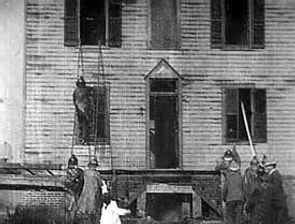Development and Principles of Editing
The Lumiere Brothers- Workers Leaving A Factory
The Lumiere Brothers were two French men who collaborated together, on Thomas Edison's creation of the Kinetoscope. Their father then encouraged them to make something better than Edison's creation of the 'Cinématographe'. This was created in1895 where the brothers combined a camera with a printer and projector. Compared to Edison’s Kinetoscope, the Cinématographe was smaller, more lightweight, and hand-cranked. The film speed was slower, 16 fps compared to Edison’s 48 fps, but its operation was much quieter. It also allowed for intermittent movement by incorporating machinery found in a sewing machine. The first screening happened on the 22nd March 1895 at 44 Rue de Rennes in Paris at an industrial meeting where a film especially for the occasion, Workers leaving the Lumière factory, was shown. This was their first film that they ever produced, and was seen as a huge spectacle for the audience. You could tell that their work was stage as nothing really happened in the film apart from movement. The work the brothers created was very basic, however the audience was very shocked as they hadn't seen anything like this before. One of the most memorable films that shocked the audience was 'Repas de bébé' this is where one of the brothers starred in the film, whilst the other recorded it of just him and his wife feeding their baby. This was shocking to the audience as they were seeing the Lumiere Brother in real life, as well as on a projection. Some of the techniques used was cutting the film and then reversing it. What they did was cut the film they had produced and then stuck the film back together but in the reverse order. This was actually a mistake made by the brothers, but was eventually successful as they managed to create a technique, which we classify as 'Rewinding' today.
Click on the first image below, to see one of the Lumiere Brothers, first film. "Workers leaving a factory"


Melies- Voyage a Travers l'imposible
George Melies was a French man and mainly worked as a full time theatrical showman whose performances revolved around magic and illusionist techniques. George Melies was there when the Lumiere brothers unveiled their Cinématographe to the public on December 28 1895. After the show he approached the Lumière Brothers with a view to buying their machine - they turned him down. After this Melies began screening other people's films which were made by the Kinetoscope, but within months he was making his own films and showing his own films. In autumn 1896 whilst Melies was filming, a rare accident occurred. His camera jammed and it then took him time to rectify the problem, not thinking that this would affect the film at all, Melies processed the film. He then saw that in the film that the camera jolting had made an impact, in that scene objects started to appear, or disappear or were transformed. Then in 1902 Melies began to experiment with camera movements to create the illusion of a character changing size, he achieved this affect by moving the camera forward. Melies discovered several other special affects when creating his own films, he discovered from this incident he had with the camera that he was able to: manipulate and distort time and space. He pioneered the first double exposure (La caverne Maudite, 1898), did his first split screen with performers acting opposite themselves (Un Homme de tete, 1898), and the first dissolve in (Cendrillon, 1899). In the film 'Voyage A Traver L'imposible he used several special effects, which shocked people the main one being hand painting the role of film. He took the film and tinting it with paint, and then played the film, which was then shown in colour.
Click on the second image below, to see Georges Méliès': Voyage à travers l'impossible

Edwin Porter- entered motion picture work in 1896, the first year movies were commercially projected on large screens in the United States. He was briefly employed in New York City by Raff & Gammon, agents for the films and viewing equipment made by Thomas Edison, and then left to become a touring projectionist with a competing machine, Kuhn & Webster's Projector scope. After travelling Edwin came back to the United States and started working, by assembling programs of Edison films, most particularly exhibitions of films of the Spanish American War. In 1899 Porter joined the Edison Manufacturing Company. From his experience as a touring projectionist Porter knew what pleased crowds, and he began by making trick films and comedies for Edison. One of his early films was Terrible Teddy, the Grizzly King, a satire made in February 1901 about the then Vice President-elect, Theodore Roosevelt. Porter tried to reinvent and improve films that were already out, however he used different techniques compared to other film makers. Instead of using abrupt splices or cuts between shots, Porter created dissolves, which were gradual transitions from one image to another.
Click on the first image to see Porter's, Life of an American Fireman.




